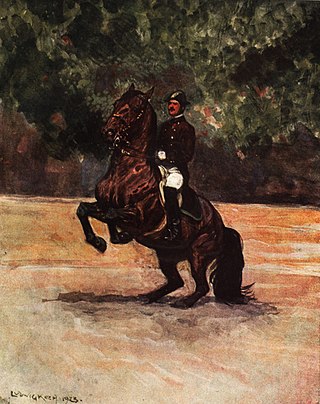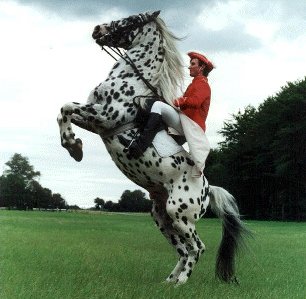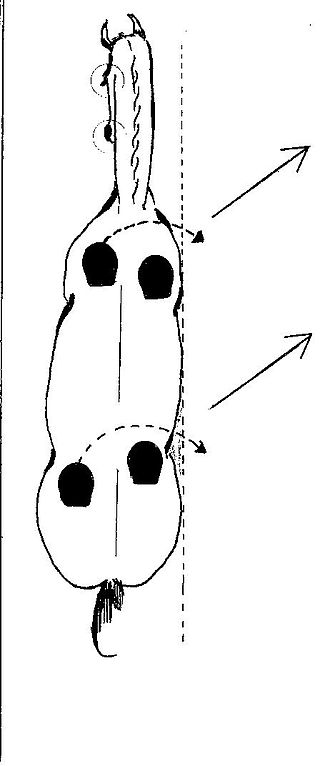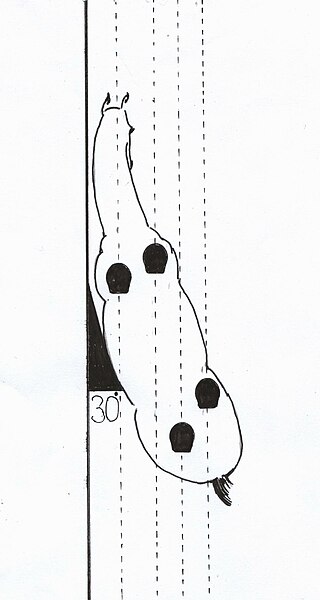
The piaffe is a dressage movement where the horse is in a highly collected and cadenced trot, in place or nearly in place. The center of gravity of the horse should be more towards the hind end, with the hindquarters slightly lowered and great bending of the joints in the hind legs. The front end of the horse is highly mobile, free, and light, with great flexion in the joints of the front legs, and the horse remains light in the hand. The horse should retain a clear and even rhythm, show great impulsion, and ideally should have a moment of suspension between the foot falls. As in all dressage, the horse should perform in a calm manner and remain on the bit with a round back.

The trot is a two-beat diagonal horse gait where the diagonal pairs of legs move forward at the same time with a moment of suspension between each beat. It has a wide variation in possible speeds, but averages about 13 kilometres per hour (8.1 mph). A very slow trot is sometimes referred to as a jog. An extremely fast trot has no special name, but in harness racing, the trot of a Standardbred is faster than the gallop of the average non-racehorse, and has been clocked at over 30 miles per hour (48 km/h).

The canter and gallop are variations on the fastest gait that can be performed by a horse or other equine. The canter is a controlled three-beat gait, while the gallop is a faster, four-beat variation of the same gait. It is a natural gait possessed by all horses, faster than most horses' trot, or ambling gaits. The gallop is the fastest gait of the horse, averaging about 40 to 48 kilometres per hour. The speed of the canter varies between 16 and 27 kilometres per hour depending on the length of the horse's stride. A variation of the canter, seen in western riding, is called a lope, and is generally quite slow, no more than 13–19 kilometres per hour (8–12 mph).

The airs above the ground or school jumps are a series of higher-level, Haute ecole, classical dressage movements in which the horse leaves the ground. They include the capriole, the courbette, the mezair, the croupade and the levade. None are typically seen in modern competitive dressage. They are performed by horses of various riding academies such as the Spanish Riding School in Vienna and the Cadre Noir in Saumur, and may be seen in other dressage performances. The levade and courbette are a particular feature of the Doma Menorquina, the riding tradition of the island of Menorca. Horses such as the Andalusian, Lusitano, Lipizzan and Menorquín are the breeds most often trained to perform the airs today, in part due to their powerfully conformed hindquarters, which allow them the strength to perform these difficult movements. There were originally seven airs, many of which were used to build into the movements performed today.

Longeing or lungeing is a technique for training and exercising horses. It is also a critical component of the sport of equestrian vaulting.

Equine conformation evaluates a horse's bone structure, musculature, and its body proportions in relation to each other. Undesirable conformation can limit the ability to perform a specific task. Although there are several faults with universal disadvantages, a horse's conformation is usually judged by what its intended use may be. Thus "form to function" is one of the first set of traits considered in judging conformation. A horse with poor form for a Grand Prix show jumper could have excellent conformation for a World Champion cutting horse, or to be a champion draft horse. Every horse has good and bad points of its conformation and many horses excel even with conformation faults.

The half-pass is a lateral movement seen in dressage, in which the horse moves forward and sideways at the same time. Unlike the easier leg-yield, the horse is bent in the direction of travel, slightly around the rider's inside leg. The outside hind and forelegs should cross over the inside legs, with the horse's body parallel to the arena wall and his forehand leading. The horse should remain forward, balanced, and bent, moving with cadence. The inside hind leg remains engaged throughout the half-pass, and the horse should not lose its rhythm.

A Pirouette is a French word for the Ballet reference, "to whirl about."
"Rein-back" is a dressage term to indicate the two-beat movement in which a horse is asked to back up. The horse picks up and sets down its feet almost in diagonal pairs, and moves straight backwards with the line of his forelegs following those of his hind. The horse should remain on the aids during the rein-back.

Rearing occurs when a horse or other equine "stands up" on its hind legs with the forelegs off the ground. Rearing may be linked to fright, aggression, excitement, disobedience, non experienced rider, or pain. It is not uncommon to see stallions rearing in the wild when they fight, while striking at their opponent with their front legs. Mares are generally more likely to kick when acting in aggression, but may rear if they need to strike at a threat in front of them.

A "baucher" is also a type of bit, named after the man.

The leg-yield is a lateral movement in which a horse travels both forward and sideways at the same time. The horse is fairly straight through his body in the leg-yield, although he may have a slight bend opposite to the direction of travel. It is one of the "three initial movements leading up to true lateral work", the others being the turn on the forehand and the shoulder-fore.

Riding aids are the cues a rider gives to a horse to communicate what they want the animal to do. Riding aids are broken into the natural aids and the artificial aids.
Lateral movements or lateral flexions within equestrianism, have a specific meaning, used to refer to movements made by a horse where the animal is moving in a direction other than straight forward. They are used both in training and in competition, vary in difficulty, and are used in a progressive manner, according to the training and physical limitations of the animal.
The turn of the haunches is a lateral movement performed at the halt and walk, used in horse training. It requires the horse, while bent in the direction of the turn, to move his forehand around his hindquarters so that he makes a very small circle with the inside foreleg. The horse should pivot around a hind-leg, as seen in the spin. Additionally, the horse should continue to display basic requirements of dressage, such as an even and regular rhythm, relaxation, acceptance of the aids, balance, and freedom of movement.

Haunches-in, also called travers or tête au mur, is a lateral movement used in the dressage discipline of horse training. It has a close cousin, haunches-out, renvers, or croupe au mur, that is slightly more difficult. Both movements are four-track, meaning they produce four lines of hoof prints in the sand, as opposed to the usual two seen if the horse is straight and to the three-track shoulder-in.
The shoulder-in is a lateral movement in dressage used to supple and balance the horse and encourage use of its hindquarters. It is performed on three tracks, where the horse is bent around the rider's inside leg so that the horse's inside hind leg and outside foreleg travel on the same line. For some authors it is a "key lesson" of dressage, performed on a daily basis.
The term forehand refers to the front half of a horse's body.
The half-halt is a specific riding aid given by an equestrian to his horse, in which the driving aids and restraining aids are applied in quick succession. It is sometimes thought of as an "almost halt," asking the horse to prepare to halt in balance, before pushing it onward to continue in its gait.

Lead refers to which set of legs, left or right, leads or advances forward to a greater extent when a quadruped animal is cantering, galloping, or leaping. The feet on the leading side touch the ground forward of its partner. On the "left lead", the animal's left legs lead. The choice of lead is of special interest in horse riding.













